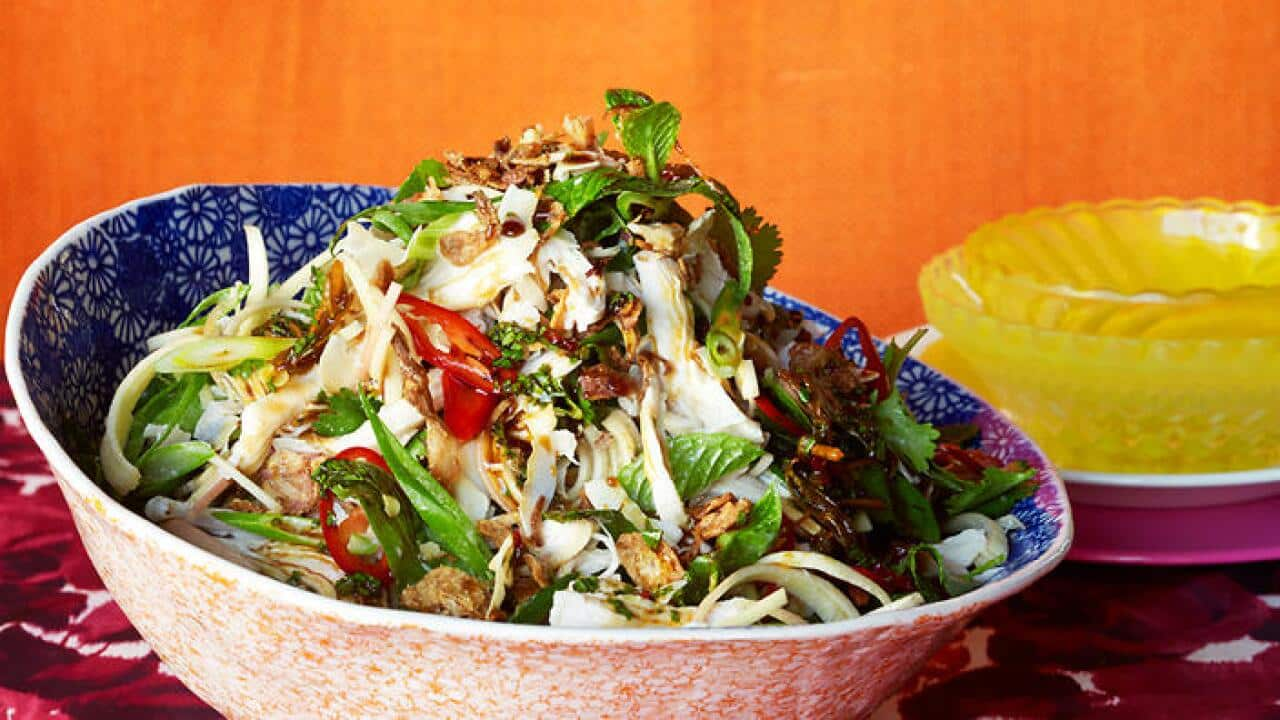When it comes to salads, I admit they have a reputation for falling short in satisfying a growling stomach on their own. However, as a cook who loves her vegetables, I have no trouble "meating up" salads with grilled vegetables and more for oomph. Whether that involves adding chunky bits of grilled pumpkin or even adding grains and pulses like borlotti beans, chickpeas and quinoa, I'm all for it.
However, rather than always going through the trouble of adding more substantial ingredients to my salad, I do have a newfound appreciation for ramping up my salad repertoire by improving its dressing.
I remember how dressings during my travels in Japan had a depth of flavour that brought a regular green salad to life. Reading countless Japanese cooking books showed me how Japanese cooks and chefs add a certain umami hit to their salad dressings, which does not include the controversial MSG. The answer: soy sauce.
WITH A TOUCH OF SOY

Cabbage salad with wafu dressing
Although a typical sauce for dressing sashimi and braising pork, soy sauce also works well in a dressing. My friends in Japan tell me three simple ingredients are used in conventional Japanese dressings: soy sauce, mirin and sake. If you know your condiments well, this resembles a ponzu sauce, which has similar ingredients plus yuzu, a zesty fruit.
That's it. As many cooks know, soy sauce is packed with umami, especially the traditionally brewed variety, which is much higher in quality and produced similarly to finely aged wine. Not only are premium soy sauces matured over time to develop rich and deeper flavours, but they also include dashi, which is made from dried seaweed (specifically kombu and bonito flakes) — ingredients rich in umami. Similarly, in Vietnam, fish sauce is used to make briny sauces such as nuoc cham. This condiment is used for dipping, but it's also suited as a salad dressing.
Similarly, in Vietnam, fish sauce is used to make briny sauces such as nuoc cham. This condiment is used for dipping, but it's also suited as a salad dressing.

A pot of umami-filled dressing makes all the difference.
Fish sauce has greater power to bring salad dressings to a whole new level. Vinaigrettes from Vietnam can rival even the best in France because they include fish sauce.
Fish sauce has greater power to bring salad dressings to a whole new level.
The condiment's deep savoury profile is salty and must be used sparingly, but when done well, it can't be forgotten in quintessential dressings like that for a bun ga nuong, another well-known Vietnamese dish made with noodles, and a nuoc cham-esque dressing to coat gloriously fresh ingredients for an easy weeknight meal. When fish sauce is used and balanced out with chilli flakes, vinegar, sugar and a splash of water, the salty fish sauce almost mellows out. Yet, it still retains its umami-rich qualities — a secret weapon for any cook who wants a flavourful dinner or lunch in a matter of minutes. , a chef at vegetarian restaurant Yellow in Potts Point, Sydney, uses umami-based dressings that feature soy and fish sauce, which she says can also work as pasta sauces.
, a chef at vegetarian restaurant Yellow in Potts Point, Sydney, uses umami-based dressings that feature soy and fish sauce, which she says can also work as pasta sauces.

Fish sauce will take a salad dressing up a notch. Source: Robert Banks
"I love adding soy and fish sauce to all my dishes, but I am currently obsessed with making a chunkier style salad dressing to coat simple butter lettuce leaves — almost like gremolata-style (dressing)," Huynh tells SBS Food. "I use a tonne of fresh chopped herbs, eschallots, chilli, capers and balsamic vinegar, which adds texture and pops of acidity, as well as saltiness."
MEET NINA HUYNH

Feels like home: This fried egg banh mi inspires courage
For Hong Kong-born chef ArChan Chan, umami-rich dressings include different ingredients. Chan says, "My quick salad dressing usually consists of fish sauce, sugar, Korean plum vinegar (or rice vinegar) and extra virgin olive oil."
He explains that fish sauce gives it umami and depth. It also suits most leaves, cabbage or tomatoes. "So, it's good for any western or Asian style salad. For many Thai salads, you just need to add some garlic and chilli to the base dressing."
TIPS FROM ARCHAN CHAN

Not made in Singapore: The curious case of Singapore noodles
In Italy, umami-rich dressings are made with another familiar ingredient: tomato paste. Tomatoes have the same properties as soy and fish sauce. Full of glutamic acid, this fruit's umami factor increases as it ripens, so when added sparingly to a dressing and balanced out with balsamic vinegar (another umami-filled ingredient) you have a rather unique and addictive dressing that rivals a mustard-based drizzle.
These little bits of knowledge can prove valuable when making salad dressings. Sometimes it's all in the finish.






